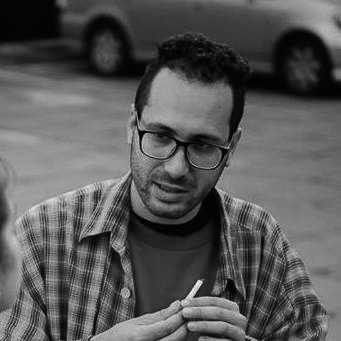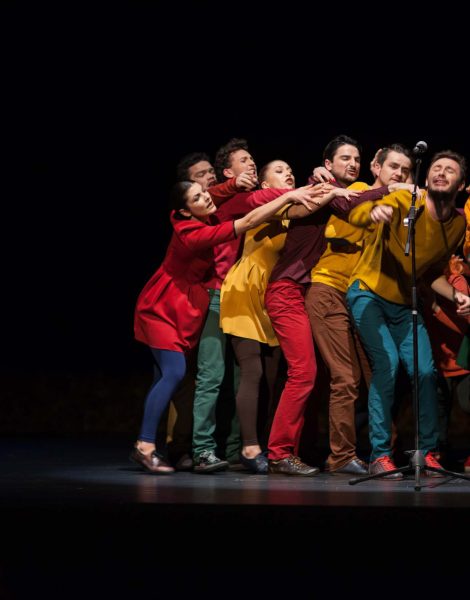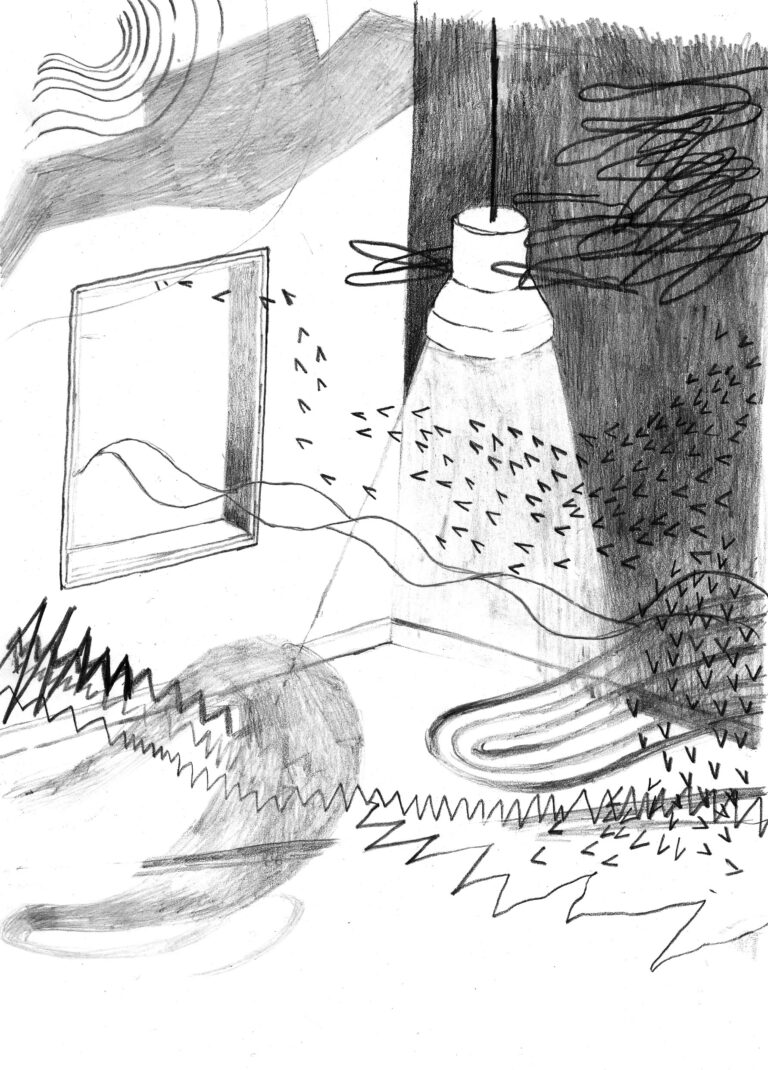Benno Voorham, coreografo olandese con base in Svezia, ha all’attivo diversi progetti che coinvolgono Paesi dell’Est europeo (Moldavia, Ucraina, Bielorussia, Georgia). Con Дом/Home ha esplorato, tramite whorkshop con bambini, le differenti accezioni che può assumere il concetto di casa, documentando l’intero processo di creazione (http://theprojecthome.org/about/). Violența, o istorie de dragoste, presentato al Teatru Ionesco di Chisinau, è una notevole prova corale, sulla parola che si fa movimento e sul movimento che si fa parola. Un continuo rimpallo di giochi verbali e gesti fisici, aneddoti individuali e racconti di una comunità che si amalgamano fino a formare un tutt’uno.
Con lui analizziamo l’approccio alla danza dei Paesi con cui ha collaborato, le energie sotterranee che caratterizzano la scena dell’est.
Hai percepito differenze tra l’approccio al teatro cui eri più abituato (olandese e svedese) e quello presente nei paesi est-europei in cui hai lavorato?
Certo, e direi che in un modo o nell’altro hanno tutte a che fare con la differente storia di questi paesi. Va detto innanzitutto che durante l’epoca sovietica erano praticamente inesistenti correnti o tradizioni sperimentali, la danza era ballet o danza popolare; sebbene alcuni club notturni sviluppassero tendenze più moderne, si trattava di casi marginali. Oggi molti giovani artisti guardano con interesse ai movimenti e alle tradizioni teatrali dell’Ovest, cercando di entrare in connessione con esse per poi integrarle nel propri lavori (è un processo che è stato particolarmente attivo negli anni ’90). Un’altra differenza sostanziale riguarda i finanziamenti: sono risibili o nulli per l’arte indipendente. Allo stesso tempo, però, esiste una ricca “infrastruttura” di teatri indipendenti che consente una circolazione di opere sperimentali di una capillarità difficilmente raggiungibile in Svezia, ad esempio. Se conosci il percorso giusto, spesso è più facile che un progetto si concretizzi in questi Paesi piuttosto che in uno di quelli in cui lavoro usualmente nell’Europa dell’ovest. Ma non parlo semplicemente di possibilità fattuali e organizzative: a volte mi chiedo se fosse stato possibile concepire gli stessi progetti che ho portato avanti in Moldavia, Ucraina o Bielorussia in un contesto come quello svedese. A livello estetico, trovo una maggiore “fisicità” nell’approccio alla danza dei Paesi dell’est, elemento che spesso mi manca, dal momento che la Svezia, a mio modo di vedere, possiede un’attitudine prettamente concettuale.
Pensi ci siano cambiamenti in atto o la situazione ti sembra statica?
Penso che ci sia una frizione interna al modo di concepire generalmente la danza in questi Paesi, che rappresenta il terreno su cui si giocano eventuali cambiamenti. A differenza dell’Ovest, dove questo passaggio è in buona parte assodato, persiste ancora una forte propensione all’intrattenimento del pubblico come urgenza primaria e fine ultimo degli spettacoli, cui molti artisti sacrificano le proprie personali tendenze artistiche o riflessioni nei confronti della società. È dunque in atto un adeguarsi a quella che, secondo una concezione tradizionale, dovrebbe essere l’aspettativa degli spettatori. Tuttavia, soprattutto nel pubblico più giovane, cresce la necessità di ritrovare a teatro un pensiero sul presente, sulla posizione dell’individuo nella società. È un processo lento, che dipende anche dagli sviluppi politici in questi Paesi, ma i cui germi sono già visibili.
Come è nato il progetto Дом/Home e come mai proprio in Moldavia, Ucraina e Bielorussia?
Non è il primo progetto che mi capita di sviluppare in quell’area. A partire dal 1995 ho iniziato a collaborare con alcune realtà teatrali delle repubbliche post-sovietiche. Si tratta di progetti che, oltre alla componente performativa finale, hanno anche momenti pedagogici che coinvolgono la popolazione locale. La prima volta che ho lavorato in Moldavia è stato nel 2000, invitato da Alexandra Soshnicova per la prima edizione del festival di danza moderna che organizzava lei stessa. Da allora sono tornato in diverse occasioni, vuoi per lezioni, workshop o performance con danzatori moldavi. Intrattengo quindi una relazione profonda con l’est Europa in generale e lo spettacolo Violența, o istorie de dragoste, andato in scena in prima nazionale a novembre al Teatrul Ionesco di Chisinau, non è che l’ultimo risultato di tale relazione.
Il progetto Дом/Home è stato inizialmente concepito nel 2009, sulla scia di un’altra performance che vedeva la partecipazione di sette danzatori provenienti da Moldavia, Ucraina e Bielorussia. Con lo stesso gruppo di persone abbiamo allora lavorato attorno al concetto di “casa”, principalmente attraverso workshop per bambini. Ci interessava cogliere le diverse accezioni che tale concetto potesse assumere nelle esperienze individuali dei ragazzi e come la loro biografia lo filtrasse, associandolo a suggestioni e relazioni anche molto diverse l’una dall’altra. Il risultato è stata la creazione di una performance finale per ciascuna delle nazioni coinvolte.
Il contesto sociale è dunque parte integrante del processo di creazione della performance.
Assolutamente. Negli ultimi anni è diventato per me fondamentale sviluppare progetti che avessero una rilevanza sociale. Come coreografo, credo che il movimento possa comunicare idee, sentimenti e riflessioni in maniera in un certo senso più libera nonché meno letterale di quanto lo sappia fare un testo. Lavorare allo stesso tempo con bambini e professionisti attraverso workshop significa dunque costruire un linguaggio comune, in cui interagiscono le diverse strutture che andranno poi a formare la performance finale. Il contesto sociale è sia premessa che conclusione del lavoro. Premessa, nella misura in cui è determinante per la formazione del concetto di “casa” da parte dei bambini così come da parte mia. Conclusione, perché la performance parla anche in maniera indiretta, attraverso il linguaggio comune di cui sopra, di un possibile approccio alternativo alle usuali relazioni fra adulti e bambini, acquisendo così una precisa valenza sociale. Direi che, in modo spontaneo, è stato “forzato” il normale rapporto adulti/bambini nella direzione di una maggiore apertura nei confronti delle istanze e delle esperienze di cui il secondo termine della relazione è portatore. Questo è diventato incredibilmente chiaro a un certo punto del processo. Inoltre, avendo a che fare con bambini, il progetto mostra un problema, quello della rottura di un rapporto di fiducia fra genitore e figlio. Ecco, ciò che abbiamo fatto, sia sul palco che nelle sessioni preparatorie, può essere riassunto come un tentativo di “riparare” tale rapporto.
Alcuni valori comunemente accettati sono stati messi in crisi?
A livello individuale, sicuramente. Era palpabile durante le prove. Il progetto ha condotto soprattutto i genitori a confrontarsi con il modo in cui entrano in contatto con i propri figli. Tutto ciò in un contesto in cui è difficile parlare e riflettere apertamente su un argomento come questo. Ma non solo, ho potuto apprezzare anche nelle discussioni successive alla performance come questa avesse provocato dubbi e ragionamenti all’interno del pubblico.
Non pensi però che l’accento sul vissuto individuale delle persone coinvolte rischi di togliere specificità artistica allo spettacolo?
Quello del vissuto individuale è solo un lato del progetto. Ovviamente dall’altra parte c’era la mia volontà di creare qualcosa che avesse il mio interesse artistico. Ma, aggiungerei, c’è una grossa differenza tra “privato” e “personale”. Il “personale” è appunto la trasformazione della tua storia privata in una dimensione pubblica, che quindi può interessare anche senza una conoscenza diretta dell’individuo cui si riferisce. Non si tratta di qualcosa necessariamente mediato da una visione generale, ma che coinvolge fin da subito il corpo del performer e la sua relazione con la complessità del materiale trattato. Nell’elaborazione che il performer compie di quest’ultimo è coinvolta la sua storia personale e, mi viene da dire, è anche ciò che fonda la dimensione “politica” della danza in quanto tale. Si tratta di un fatto su cui ho acquisito sempre più consapevolezza durante la gestazione dei miei ultimi spettacoli. Ci sono spettacoli chiaramente più o meno espliciti su questo punto, ma ciascuno di essi riflette sempre il punto di vista politico di chi ci ha lavorato. Ogni nostra azione è politica, non credo esista un modo per evitare di posizionarsi politicamente di fronte alla realtà.
ENGLISH VERSION
Benno Voorham is a dutch coreographer based in Sweden; he was involved in several projects and collaborations in Easter Europe (Moldova, Ukraine, Belarus, Georgia). With Дом/Home he explores, organizing workshops with children, the different characteristics the concepts of home can take, documenting the entire creative process (http://theprojecthome.org/about/).
Violența, o istorie de dragoste, presented Teatru Ionesco in Chisinau is a great choral essay of speech turning into movement and movement turning into speech. Personal anecdotes and communal tales merge and play with verbal puns and bodily gestures slowly becoming one. We are about to analyze with him the approaches dance has in the countries where he worked, the subterranean energies marking the eastern dance scenario.
How the Home project was born and why it took place in Moldova, Ukraine and Belarus?
It’s not my first experience in those countries. Since 1995, I’ve been collaborating with theater professionals from former Soviet republics. The projects I was part of usually involved also members of the local community participating in workshops aimed at developing the final show. My first time in Moldova was in 2000 and I was invited by Alexandra Soshnicova who was setting up a dance festival. Since then, I came several times for performances, workshops or collaborations with Moldavian dancers. Therefore, I would say that I have a strong connection with Eastern Europe in general and Violența, o istorie de dragoste, which had the national premiere at Ionesco Theater in Chisinau in November, is the last outcome of this connection.
Home project was conceived in 2009 on the wake of a previous collaboration with seven dancers from Moldova, Ukraine and Belarus. We started to focus on the idea of “home” and we ran a workshop for children about the concept. We were interested in discovering how each child’s personal story and the different environments they grow up in changed their intimate idea of “home”. Each one of them had different feelings and sensations about it. At the end of the workshop, we created a final performance for each one of the countries involved.
So, the social context you are working in is strictly connected with the process involved in creating the performance?
Definitely. During the last years, developing projects with a social significance became more and more important for me. As a choreographer, I believe the body movement can express ideas, feelings and thoughts in a freer (even though less literal) way than a text can do. Working with professionals and non-professionals (like children) at the same time means building a “common language”, by means of which different influences merge into the final performance. I would say that the social context is both the premise and the conclusion of the creative process. On one hand, it is the premise because it is fundamental in order to forge the idea of ‘home’ in the children’s mind and in mine as well. On the other hand, it is the conclusion since the final performance has a social significance: the purpose is to use the “common language” I was speaking about to show relationship between adults and children potentially different from the usual ones. Somehow, we tried to break the standard family bonds so to give more attention to children’s feelings and thoughts, which are usually hidden. At a certain point it became extremely clear what we were dealing with: the problem of breaches into parents\sons relationships. Our workshop was somehow an attempt to repair those breaches.
Can we say that some commonly accepted values were called into question?
At an individual level, for sure. You could clearly feel it during the rehearsals. The workshop was questioning each parent about the way he usually connected with his or her child, in a society where the subject is a sort of taboo. Plus, when we had open discussion after the performances, I could appreciate that the show was able to provoke reflections and doubts even in the audience.
So, you focused deeply on personal stories and individualities. How did you combine these elements with the artistic side of the project?
Of course personal stories and individualities represent only one side of the projects. The other side was my will to create something artistically interesting. But, I must say, there is a strong difference between “private” and “personal”. “Personal” is precisely the transformation of private events and feelings into something that can be interesting without directly knowing the person from who those event and feelings are coming from, that is to say into a public dimension. By achieving this dimension, you can involve directly the performer’s body and transform all the material you gathered into an artistic show. This is what founds the political aspect of dance as such. I think every act has a political meaning: you cannot avoid taking a political position towards reality. Every performance, despite being more or less explicit, will always reflect the political point of view of who worked on it.
Did you see any difference between the approach to theater you were more used to (namely, Swedish and Dutch one) and the approach of Eastern European countries you worked in?
I saw several differences that in my opinion have to do with the history of these countries. First of all, we must consider that during soviet times there were no experimental trends, apart from some underground experiences: back then dance meant just ballet or folk dance. Nowadays (but also in the 90s), lots of young artists started looking into Western Europe theater tradition in order to assimilate its influences into their own works.
One big difference arises when it comes to funding which is really low for independent theater. But, on the other hand, Eastern countries still have a well-working network of theaters where you can set up a greater circulation of independent works than in, say, Sweden. In the eastern countries if you know the right path you can maybe realize your project more easily than in Western ones. This is true also at the artistic level: I would say that some of my project could have been born only in Eastern countries because some of their artistic elements might not have been accepted in other contexts. Plus, I found a physical approach to dance that I was really missing, since in Sweden a more conceptual one prevails.
Do you think the theater situation in Eastern countries is developing or rather it is static?
I think there are internal frictions in the various approaches to theater, which maybe can trigger also broader changes at institutional level, etc. I would say that in Eastern Europe when the show is created the audience’s expectations are taken into account more than in Western Europe. In other words, sometimes artists sacrifice their artistic inclinations or their critical opinions towards society not to disappoint the public. However, especially in young spectators, the need for a theater that reflects on current times, on the position the individual should have in the society, is growing. This is a process that will depend on the political development of these countries but whose seeds are already planted.
Revisione inglese a cura di Raffaele Cavalli
L'autore
-

Giornalista e corrispondente, scrive di teatro per Altre Velocità e segue il progetto Planetarium - Osservatorio sul teatro e le nuove generazioni. Collabora inoltre con il think tank Osservatorio Balcani e Caucaso Transeuropa, occupandosi di reportage relativi all'area est-europea.







